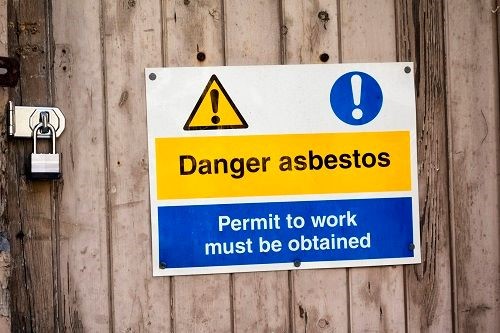The ban on the importation and use of asbestos in the UK by a Labour government back in 1999 was welcomed by those who had campaigned for it and by health and safety professionals who had to deal with the deadly substance on a daily basis.
Opinion
Asbestos in schools: government must start to fund its removal
However, the move didn’t mean that the dangers from asbestos exposure were eradicated. Instead, the nature of the exposure has changed.
Over recent decades, Britain’s industrial landscape has undergone huge changes with a reduction in heavy industrial activities, like shipbuilding, where asbestos use and exposure was commonplace.
The use of asbestos in lagging for insulation in locations like industrial and building pipework has also ended. The latency period of the effects of exposure to asbestos fibres on the lungs means that large numbers of the current deaths from asbestos-related disease are due to past exposures in activities like industry. However, cases of asbestos exposure today increasingly happen in the built environment.
 Postponing measures like the removal of the most risky asbestos materials means that school staff, children and others continue to be exposed to the deadly fibres. Photograph: iStock
Postponing measures like the removal of the most risky asbestos materials means that school staff, children and others continue to be exposed to the deadly fibres. Photograph: iStock
One environment where the risk of exposure is significant is schools, and many of those working in schools – such as teachers – have no idea that asbestos is present in their workplace. This is perhaps ironic given that many years ago asbestos was termed ‘the hidden killer’ due to the fact the fibres are invisible to the eye.
To understand the extent of the problem of asbestos in schools – and the lack of major action by successive governments – it is necessary briefly go back in history. The bombing of Britain during the Second World War resulted in a massive building programme of housing, hospitals and schools.
As the population grew there was also the need for more new schools to educate what became known as the Baby Boomer generation. Asbestos was available at relatively cheap prices from Commonwealth countries (mainly Canada), and it was both a good heat and sound insulator.
Although asbestos legislation had applied to factories since the 1930s, there were no general laws on controlling exposure to it in other workplaces, other than measures aimed at dealing with asbestos dust as a nuisance and irritant. Indeed, some trade unions often negotiated a premium for people working in such conditions. In 1965, a clear link between asbestos exposure and mesothelioma – an incurable asbestos disease – was established and gradually the issue of asbestos exposure was legislated for.
 JUAC is calling for the reintroduction of proactive inspections of school premises for asbestos risks and management plans. Photograph: iStock
JUAC is calling for the reintroduction of proactive inspections of school premises for asbestos risks and management plans. Photograph: iStock
Schools are unlike any other workplace mainly because they contain children who do not behave as most adults do. Children can be boisterous, curious and mischievous, are interested in interacting with their environment and often move in large groups. All of these factors increase the risk of them accidentally damaging and disturbing asbestos-containing materials, placing themselves and school staff at risk of exposure.
Asbestos has been present in some schools for over 50 years and can be subject to ongoing wear and tear and damage during general repairs and refurbishment work. Given these risks, it might be expected that successive governments would have developed a systematic long-term plan to deal with asbestos in schools. Unfortunately, it can reasonably be claimed that the reverse is true and each administration kicks the can down the road for someone else to deal with the problem.
In addition, the Coalition government of 2010–2015 brought in a deregulatory approach – combined with a reduction in resources and expertise for the workplace regulator, the Health and Safety Executive (HSE). The Coalition government also changed how money was allocated to schools for rebuilding and refurbishment. So, incredibly, 23 years after the use of asbestos was banned it is estimated that 85 per cent of schools still contain the material. The estimate is based on the fact that no comprehensive records exist on where and how much asbestos was used or how much has been removed.
Often those deemed to be the dutyholder with responsibility for managing the school and any asbestos present are head teachers, bursars and academy directors. These people have little or no knowledge of the subject and already have a full agenda of other issues and instructions dictated by the Department for Education.
Lack of information on the location and condition of asbestos
The regulations on managing the risks from asbestos and recording its locations and condition can be difficult to interpret without specific training. For those working in a school there is often a serious lack of information on where asbestos is located and more importantly the condition it is in. In theory, the presence and condition of asbestos should be recorded and monitored on a regular basis and staff or contractors working in areas where the substance could potentially be damaged or disturbed should be informed of this.
The Joint Union Asbestos Committee (JUAC) was set up by trade unions representing education workers like teachers and support staff, in an attempt to improve everyone’s awareness, understanding and knowledge about the nature and extent of the risk of asbestos exposure in schools. Of course, our principal concerns are the staff we represent but this cannot be tackled in isolation as the children, parents, visitors and contractors are also vulnerable to asbestos exposure.
JUAC has taken a consistent approach for over a decade on the problem that asbestos poses to schools and their occupants.
The JUAC’s demands include:
- The reintroduction of proactive inspections of school premises to assess asbestos risks and the effectiveness of the dutyholder’s management system for reducing the risk of exposure. This must include adequate resources for HSE to carry out the inspections
- The identification of the most severely damaged asbestos and a comprehensive plan and financial resources to prioritise its removal
- Adequate training for all school staff so they receive adequate information about the presence, condition and arrangements for managing asbestos in their school, and better enforcement of their right to be given this information
- Annual information for parents and the local community on the state of asbestos in the school
- New regulations specifying lower asbestos exposure levels in buildings like schools and investment in monitoring technology that can ensure these levels are not breached
- Comprehensive training for building surveyors – particularly those who cover schools – on the legal rules setting out how to effectively manage the risk of exposure to asbestos in buildings.
JUAC acknowledges that these measures are potentially expensive. However, repeatedly postponing measures like the removal of the most risky asbestos materials means that school staff, children and others continue to be exposed to the deadly fibres.
At the current rate of dealing with an increasingly deteriorating education estate one senior civil servant off the record stated that it would take 300 years to remove all asbestos from all schools. In the meantime, over 5,000 people will die every year from asbestos-related diseases, of which over 2,500 are deaths from mesothelioma.
The longer we put off dealing with this deadly problem the more people will die. Even in a climate fraught with political and economic difficulties we need to immediately implement a coherent and comprehensive plan for dealing with the legacy of asbestos in schools.
More information at: the-juac.co.uk
John McClean is Chair of JUAC (Joint Union Asbestos Committee)
OPINION

The air we breathe is all our business
By Nicky O’Malley, director of corporate partnerships, Global Action Plan on 01 June 2023
Businesses have a vital role to play in improving air quality – and the UK’s Clean Air Day on 15 June is a great opportunity for companies to begin or renew their efforts in this area.

All jobs greener: why we need workforce transformation for a sustainable future
By Martin Baxter, deputy CEO, IEMA (Institute of Environmental Management & Assessment) on 01 June 2022
The shift to a green economy will create green jobs within new and emerging sectors, while those working in existing sectors will have to gain the requisite green skills to take advantage of the business value-creation opportunities that come from embedding sustainability across the whole organisation.

Preventing chemical pollution: how the UK is falling behind Europe
By Ruth Jones MP for Newport West & Shadow Minister for Agri-Innovation and Climate Adaptation on 01 June 2023


